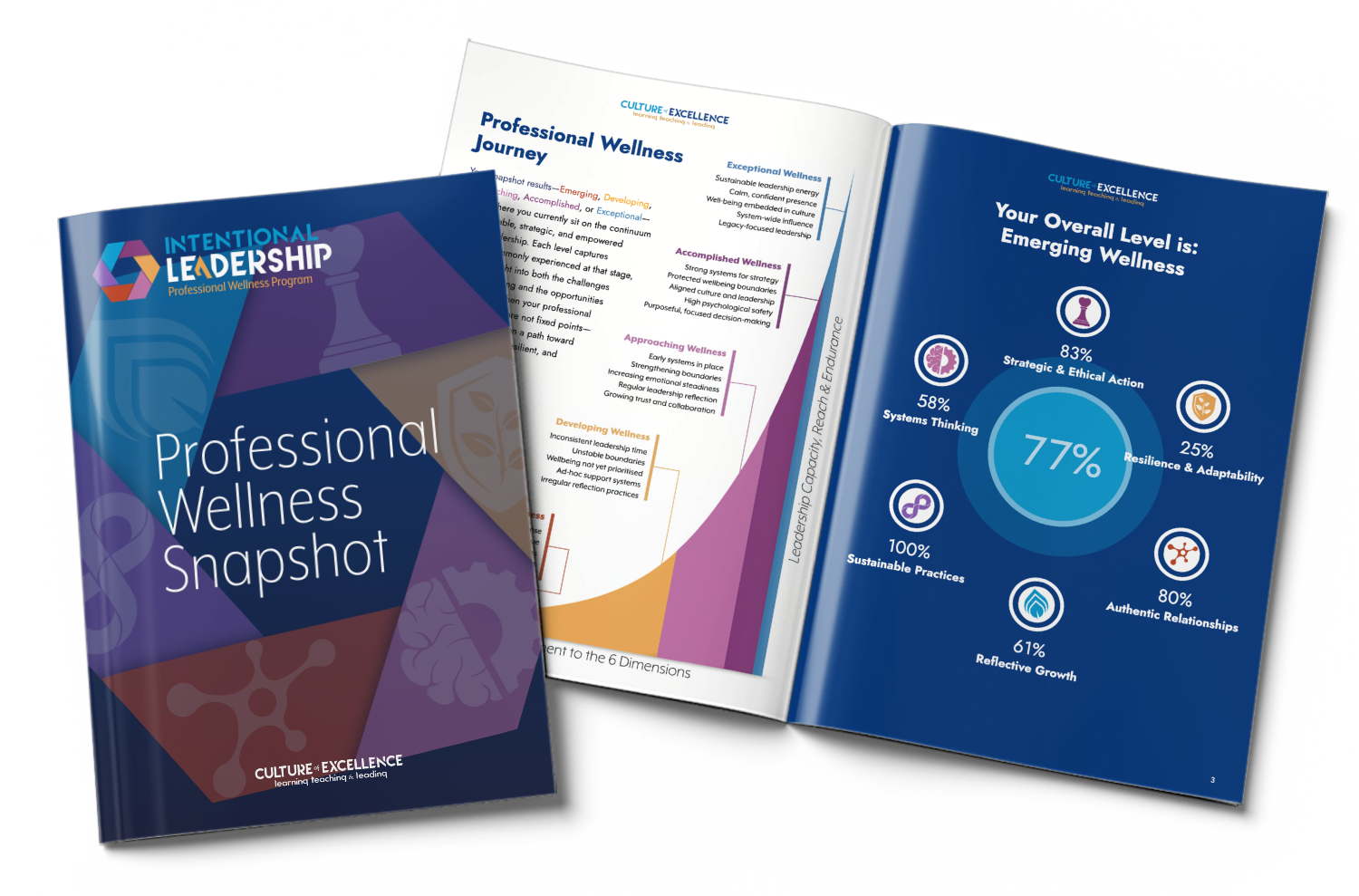
The Invisible Wall of Compliance
When rules outrun reason, and leadership gets stuck enforcing, not evolving
This video unpacks how the hidden burden of compliance quietly shapes—and often shrinks—school leadership. It’s not just about red tape. It’s about how systems that were meant to protect quality often prevent progress. When compliance becomes the culture, innovation suffocates.
What part of your leadership is most shaped by compliance right now—and what would it take to shift from enforcer to innovator?
Want to Lead With Steadiness—Not Strain?
Join our FREE Professional Wellness Workshop—a live session where we explore all six dimensions and help you refocus on what really sustains school leadership.

The Invisible Wall of Compliance
When rules outrun reason, and leadership gets stuck enforcing, not evolving
There’s a moment in the leadership journey where something shifts. It’s not dramatic; it’s quiet. And it doesn’t show up in KPIs.
You still do the job. But you’ve stopped pushing. Instead, you’ve started filtering every decision through one core question: “Will this be allowed?”
This isn’t a one-off moment of fear. It’s the result of what I call the Invisible Wall of Compliance—a subtle but powerful cultural constraint that teaches even the best leaders to shrink. And it’s everywhere.
The Emotional Weight of Shackled Authority
This isn’t new. In Shackled Authority, I explored how school leaders today are expected to carry full accountability while operating under limited agency. They are leaders in title—but functionally restricted to maintaining systems they didn’t design.
In this article, I want to go deeper into the emotional reality of that condition. Because compliance culture doesn’t just change what we do. It changes who we become.
Over 56% of Australian principals have considered leaving the profession (Riley et al., 2023). And while factors like workload and aggression from parents are real, the more corrosive factor is existential:
“I don’t feel like I’m leading anymore.”
How the Wall Builds Itself
The wall doesn’t arrive all at once. It assembles itself over time—through policies, expectations, subtle punishments, and a culture that rewards obedience over originality. It’s reinforced every time a new idea is met with:
- “That’s not in the guidelines.”
- “That’s not our role.”
- “That might be too risky.”
And after enough of these, leaders stop trying.
Four Truths Behind the Wall
1. Compliance Rewards Safety, Not Vision
You’re encouraged to lead, but only within tightly defined boundaries. Vision is welcome—so long as it doesn’t challenge what already exists.
This tension, what Cranston (2018) calls “ethical compression,” reduces moral leadership to procedural maintenance. Leaders no longer ask, What is right? They ask, What’s compliant?
It echoes what we surfaced in The Trust Dilemma, where fear replaces honesty—and caution becomes culture.
“We don’t need your judgment—we need your alignment.” That’s the message compliance sends—even if it’s never spoken.
2. Micromanagement Becomes Cultural, Not Personal
One of the strongest responses to our carousel post for this topic was from a principal who said: “I censor myself before anyone else can.”
That’s the power of embedded compliance culture. It doesn’t require active suppression—it trains self-suppression. Leaders learn to silence their boldest instincts because they’ve internalised the likely pushback.
This anticipatory restraint is a hallmark of what Seligman (1972) termed learned helplessness: when people stop trying because failure has become predictable.
3. Authenticity Breaks Under Pressure
You still believe in your values. But when policies contradict them, you either pretend to agree—or stay silent. Both choices erode trust, especially the trust your staff have in you.
This came through clearly in the video version of this topic, where I shared how leaders begin to feel split in half—performing leadership on the outside while suppressing their convictions inside.
Bryk and Schneider (2002) argue that trust is the core resource for any improvement—and trust dies quickly when authenticity is sacrificed.
4. Innovation Becomes Optics
You pilot ideas. But only if they’re risk-free, and only if they align neatly with department goals or external reviews. And over time, your boldest thinking gets shelved in favour of what’s safe to showcase.
As I shared back in Are You Measuring What Matters?, even our metrics start to reflect optics, not outcomes. Compliance begins to shape how we define success.
What This Culture Costs
Leaders retreat into task lists, teams stop challenging each other, and schools begin to drift—not because people don’t care, but because no one feels safe to lead with conviction.
This is not just an operational issue. It’s a wellness issue.
Two Dimensions That Help Break the Wall
Inside the Professional Wellness Program, we help leaders map their pressures against six core, evidence-based dimensions of wellness.
For this issue, two matter most:
→ Systems Thinking
If you feel boxed in, it’s not enough to blame the system. You have to trace it.
- Where did the restriction originate?
- What assumptions is it built on?
- What pressure is reinforcing it?
Once you map the system, you can influence it. You stop reacting—and start redesigning. Fullan (2020) calls this “leading from the middle”—understanding and influencing systems without waiting for top-down permission.
→ Authentic Relationships
Staff don’t need you to break the rules. But they do need to see that you’re not pretending the rules make sense when they don’t.
When you name the tension, you earn trust. And when you navigate it openly, you model real leadership under pressure.
You can measure where this pressure is showing up using the free Professional Wellness Snapshot. It’s private, evidence-based, and takes just five minutes to complete.
A Final Thought
We’re not talking about rogue leadership. We’re talking about principled leadership—executed within systems that make it increasingly difficult. The wall won’t collapse overnight, but it begins to weaken when you name it. When you stop pretending it isn’t there.
And when you start rebuilding trust by showing up with honesty—even when constrained.
This wall was built to keep leaders in line. But it only holds power if we stop questioning it.
References
Bryk, A. S., & Schneider, B. (2002). Trust in schools: A core resource for improvement. Russell Sage Foundation.
Cranston, N. (2018). Ethical dilemmas in school leadership: Can they be avoided? Leading & Managing, 24(1), 1–13.
Fullan, M. (2020). Leading in a culture of change (2nd ed.). Jossey-Bass.
Riley, P., See, B. H., & Marsh, H. (2023). Australian Principal Occupational Health, Safety and Wellbeing Survey. Australian Catholic University.
Seligman, M. E. (1972). Learned helplessness. Annual Review of Medicine, 23, 407–412.

Not Sure What's Holding You Back?
Take our quick 2-minute Professional Wellness Snapshot to pinpoint where your biggest barrier lies—and which leadership dimension to strengthen next.